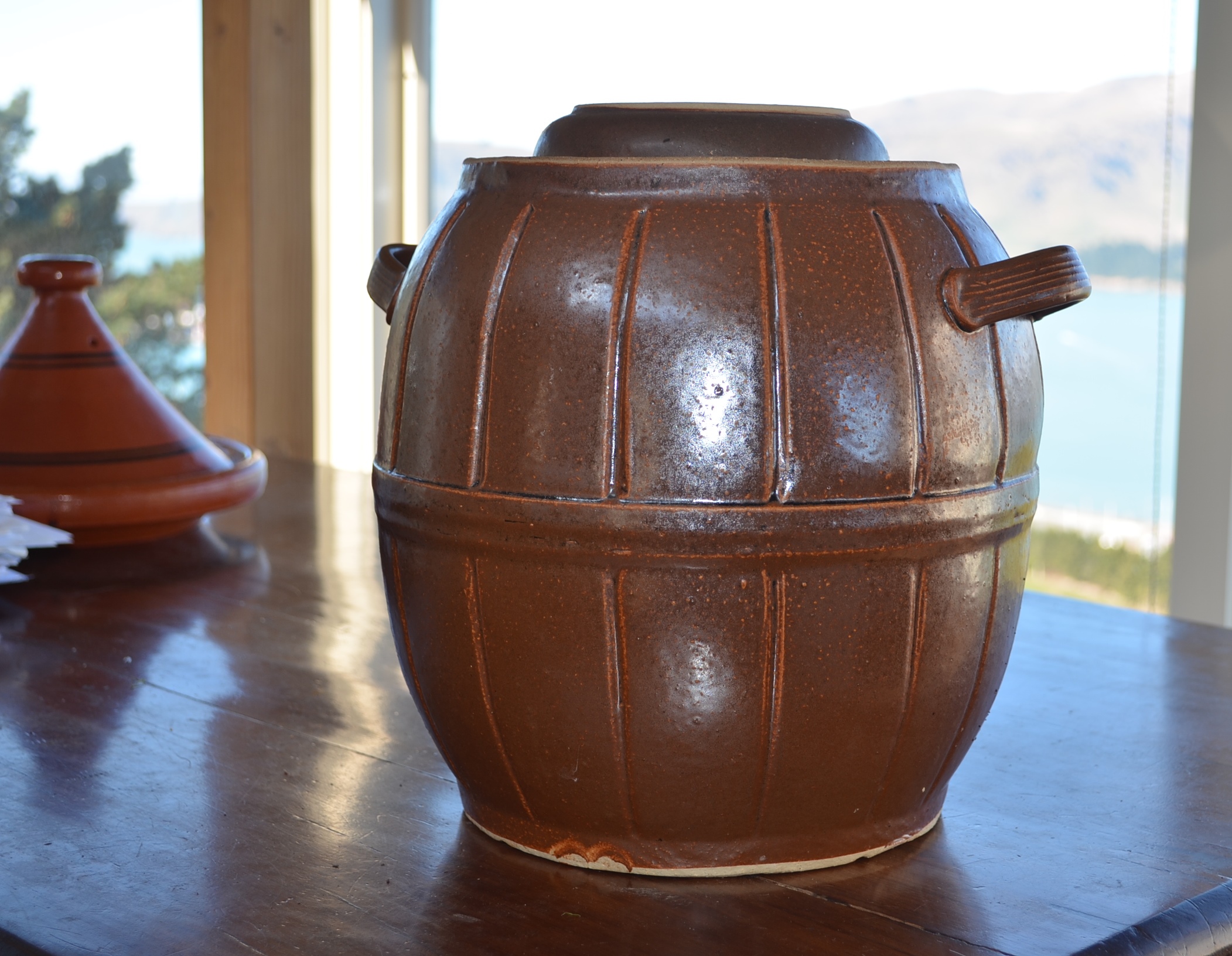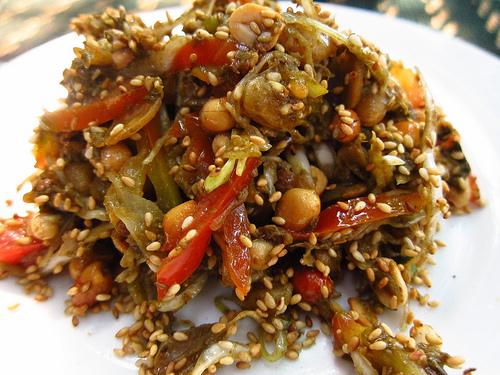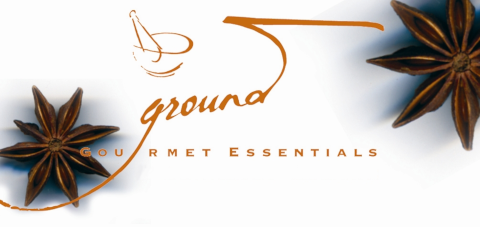I know that fermented food is good for you. It is all the rage from kombucha to kimchi, sauerkraut to sourdough, kefir to kashk. People have got the fermentation bug.
I absolutely hate sauerkraut, but adore kimchi. Go figure; both are variations on fermented cabbage. I guess I need that chilli hit. I also really love Burmese fermented tea leaf salad. Lahpet Thoke (pronounced “la-pay toe”) is the national dish of Burma, and our local Burmese restaurant (The Bodhi Tree) serves up a delicious one. However it is difficult to make at home because you need to get your hands on some fermented green tea leaves. And it seems like no-one in New Zealand sells them. A quick google search for recipes to make your own fermented tea leaves brought up a whole lot of cheats versions, where the tea leaves were cooked in vinegar- making them pickled, not fermented- quite a different thing altogether. As usual I wanted the authentic thing. So I bought myself a really old-fashioned fermentation pot and begged a recipe from a Burmese friend.

This salad is so important to the Burmese culture that when tea leaves are harvested, the best of the crop is set aside for fermenting, while the rest is dried and processed for drinking tea. Since most likely you won’t have access to fresh tea leaves, dried green tea leaves work pretty well.
Fermenting the tea leaves
1 cup dried green tea leaves, loosely packed
1 cup kale, green cabbage or Chinese cabbage, finely chopped or shredded
½ cup finely chopped coriander, loosely packed,
½ cup spring onions, finely chopped
1 tablespoon garlic paste
2 tablespoons finely chopped ginger root
juice squeezed fresh from one lime
generous pinch of salt
Pour 4 cups of hot water over the dried tea leaves, stir, and let soak until the leaves have expanded and are quite soft, about 10 minutes. Then drain, pick through the leaves, and discard any tough bits. Squeeze out any remaining liquid from the tea leaves as thoroughly as possible. Next place the tea leaves in lukewarm water and mash with your hands a little. Drain and squeeze out extra liquid. Repeat this rinse once more, then add cold water and let stand for 1 hour (or as long as overnight). This longer soak helps to remove the strongest, tart and bitter edge of the tea. Drain, squeeze thoroughly to remove excess water, and discard any remaining tough bits. Chop the leaves finely and mix together with the kale, coriander, spring onions, ginger, garlic paste, a generous pinch of salt and the lime juice.

Put this mix into your fermentation jar and allow it to ferment, untouched, for two to four days in a dark, cool space, like a pantry. You know that the fermentation process is working with this pot because you can hear the little bubbles popping in water in the rim of the lid. When it is ready I tend to give the tealeaf mix a short burst in the food processor to mash up all the ingredients, before transferring it to a container to keep in the fridge. It is now ready to be made into salad!
To make the salad
About ¾ cup packed fermented tea leaves
2 tablespoons toasted sesame seeds, lightly ground
2 to 3 tablespoons roasted peanuts, whole or coarsely chopped
2 to 3 tablespoons fried split roasted lentils
½ cup thin tomato wedges
2 tablespoons dried shrimp, soaked in water for 20 minutes and drained
1 cup shredded green cabbage or Chinese cabbage (optional)
Salt
Dressing
1 to 2 tablespoons garlic oil- see below
1 to 2 tablespoons fresh lime juice
1 teaspoon soy sauce or fish sauce
Pinch of salt
Heat the peanut oil over medium-high heat, add the sliced garlic, reduce the heat to medium and fry until just golden, about 5 minutes. Lift the garlic out of the oil with a slotted utensil and set aside on a plate to crisp up. Save the oil, now flavoured with garlic, to use in the final dressing.
Toss the fermented tea leaves with the reserved garlic oil, a few splashes of fish sauce, and fresh squeezed lime juice to give an extra sour note. Add a generous pinch of salt, mix again, taste and adjust other seasonings if needed. Mix in all the other ingredients including the crunchy mix-ins.

I have made kimchi quite a few times using my fermentation pot. I am an addict for the sour, spicy umami flavour of kimchi, and I know it is good for me so am happy to keep making a regular supply. I usually cut my Chinese cabbage into pieces before salting them overnight and then draining them to make the kimchi. It always works well. But recently my Korean friend So Young, came out from Seoul for 3 weeks with her kids. It was supposed to be a holiday for her, but I couldn’t keep her out of the kitchen. I would come home from work to find her preparing side dishes galore, or pajeon pancakes for a snack, or japchae to take to a friend’s BBQ, or rice and meat for a blugolgi dinner. And she seemed to be forever doing the dishes. I did learn quite a few refinements to the Korean dishes I have in my repertoire.

I was especially keen to see her make her version of kimchi to see where I could improve. She made it a couple of times during her stay, so that I would have plenty in the fridge after she went.
So Young used 4 or 5 whole Chinese cabbages to make her kimchi. She didn’t cut them up at all. But she did use some unusual ingredients when making the kimchi mix. First she salted the cabbages in water with about ½ cup of salt for 24 hours or at least 1 night. Then she drained them and squeezed out all the liquid thoroughly. She then let them drain for another 24 hours. According to So Young this length of sitting draining is very important. Of course this process breaks down the cells of the cabbage leaves, making it limp and shrink in size.

When she was satisfied with how long they had drained, she put together the rest of the ingredients.
Ends and skins saved from the last time you peeled a brown onion
10 ikan bilis- heads only
Leftover rice pot scrapings
1 daikon radish, peeled and cut into matchsticks
2 carrots, peeled and cut into matchsticks
4 spring onions, ends trimmed, cut into 2cm pieces (use all parts)
¾ cup Korean red pepper powder (gochugaru)
¼ cup fish sauce
¼ cup peeled and minced fresh ginger
1 tablespoon minced garlic cloves (from 6 to 8 medium cloves)
1½ teaspoons sugar
1 teaspoon salt

She finely julienned daikon radish and carrot. In a small pot she boiled up some onion skins and ends and the heads of some dried anchovies (ikan bilis) in just a little water. She also added a little water to the leftover scrapings of rice in the bottom of a pot and boiled this to make a milky liquid. She then blitzed the rice and water together with the drained water off the onions and anchovies. This was then mixed into gochugaru, mashed garlic, grated ginger, fish sauce, salt and sugar. She then thoroughly mixed that in with the freshly cut daikon, spring onion and carrot.

Grabbing big handfuls of this mix she rubbed it in between each leaf of each cabbage, making sure the cabbage didn’t break apart. She then carefully wrapped the thin outer leaf firmly around the cabbage to make a compact bundle.

These all went into a plastic container which was placed outside on the breezy porch for 2 or 3 days to ferment.

I asked her why she didn’t use the fermentation pot and she said that she thought the kimchi fermented well enough in a plastic container, and she preferred not to move it around after fermenting, i.e. transferring it into a container to go in the fridge. So after 2 days outside we tucked in. Mashisayo.
